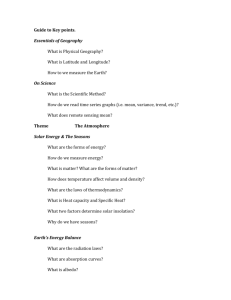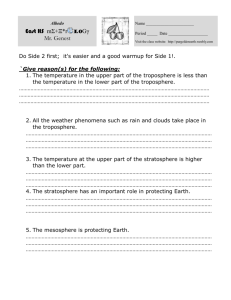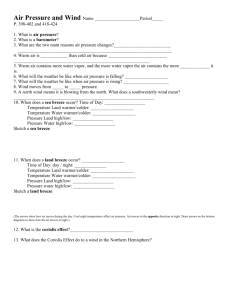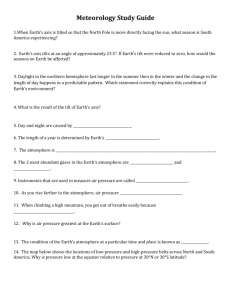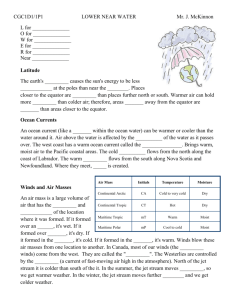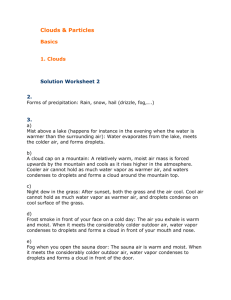21111 PHYSICS DEPARTMENT MET 1010 Midterm Exam 2
advertisement
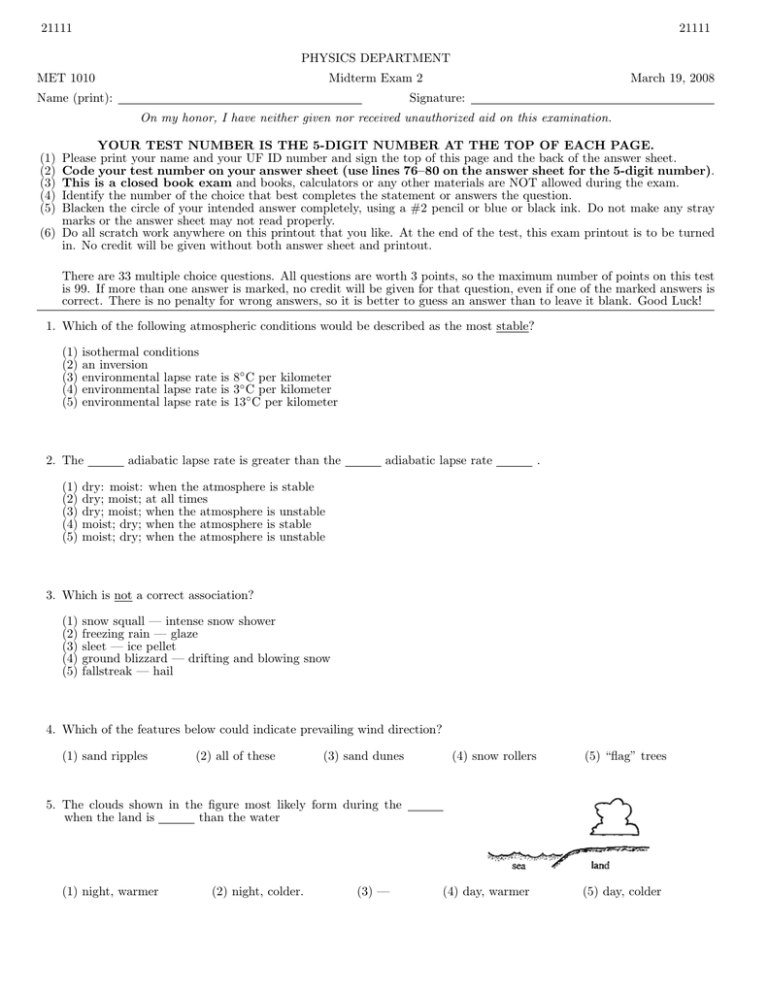
21111 21111 PHYSICS DEPARTMENT MET 1010 Midterm Exam 2 Name (print): March 19, 2008 Signature: On my honor, I have neither given nor received unauthorized aid on this examination. YOUR TEST NUMBER IS THE 5-DIGIT NUMBER AT THE TOP OF EACH PAGE. Please print your name and your UF ID number and sign the top of this page and the back of the answer sheet. Code your test number on your answer sheet (use lines 76–80 on the answer sheet for the 5-digit number). This is a closed book exam and books, calculators or any other materials are NOT allowed during the exam. Identify the number of the choice that best completes the statement or answers the question. Blacken the circle of your intended answer completely, using a #2 pencil or blue or black ink. Do not make any stray marks or the answer sheet may not read properly. (6) Do all scratch work anywhere on this printout that you like. At the end of the test, this exam printout is to be turned in. No credit will be given without both answer sheet and printout. (1) (2) (3) (4) (5) There are 33 multiple choice questions. All questions are worth 3 points, so the maximum number of points on this test is 99. If more than one answer is marked, no credit will be given for that question, even if one of the marked answers is correct. There is no penalty for wrong answers, so it is better to guess an answer than to leave it blank. Good Luck! 1. Which of the following atmospheric conditions would be described as the most stable? (1) (2) (3) (4) (5) isothermal conditions an inversion environmental lapse rate is 8◦ C per kilometer environmental lapse rate is 3◦ C per kilometer environmental lapse rate is 13◦ C per kilometer 2. The (1) (2) (3) (4) (5) adiabatic lapse rate is greater than the adiabatic lapse rate . dry: moist: when the atmosphere is stable dry; moist; at all times dry; moist; when the atmosphere is unstable moist; dry; when the atmosphere is stable moist; dry; when the atmosphere is unstable 3. Which is not a correct association? (1) (2) (3) (4) (5) snow squall — intense snow shower freezing rain — glaze sleet — ice pellet ground blizzard — drifting and blowing snow fallstreak — hail 4. Which of the features below could indicate prevailing wind direction? (1) sand ripples (2) all of these (3) sand dunes (4) snow rollers (5) “flag” trees 5. The clouds shown in the figure most likely form during the when the land is than the water (1) night, warmer (2) night, colder. (3) — (4) day, warmer (5) day, colder 21111 21111 6. Which of the following forces can not act to change the speed of the wind? (1) Coriolis force (2) — 7. Vertical mixing of air tends to (1) decrease (2) — (3) none of these (4) pressure gradient force (5) frictional force a large environmental lapse rate (3) — (4) have no effect on (5) increase 8. The surface pressures at the bases of warm and cold columns of air are equal. Which of the following statements is not correct? (1) (2) (3) (4) (5) the cold air is more dense than the warm air the pressure aloft is higher in the warm column the weight of each column of air is the same pressure will decrease with increasing height at the same rate in both columns both columns of air contain the same total number of air molecules 9. The main difference between a cloud drop and a raindrop is its (1) none of these (2) size (3) color (4) temperature (5) shape 10. At the same sub-freezing temperature, the saturation vapor pressure just above a liquid water surface is saturation vapor pressure above an ice surface. (1) the same as (2) — (3) — (4) less than the (5) greater than 11. The intertropical convergence zone (ITCZ) is a region where: (1) (2) (3) (4) (5) the Ferrel cell converges with the Hadley cell northeast trades meet the southeast trades northeast trades converge with the subtropical high polar easterlies converge with the air at the doldrums the polar front meets the subtropical high 12. What is the direction of the pressure gradient force at point A in the figure? (1) (2) (3) (4) (5) down — toward the right toward the left up 13. Suppose one morning you notice radiation fog outside which indicates an absolutely stable atmosphere. The outside thermometer shows 15◦ C. What can you say about the temperature of the atmosphere at an altitude of 1000 m? (1) it is at least 5◦ C (2) it is at most 5◦ C (3) it is at least 9◦ C (4) it is about 15◦ C (5) it is at most 9◦ C 21111 21111 14. An example of microscale motion is: (1) (2) (3) (4) (5) winds on a surface weather map of North America winds on a 500 mb chart average wind patterns around the world winds blowing through a city winds blowing past a chimney 15. Virga is another name for (1) (2) (3) (4) (5) a true blizzard a light shower of snow that falls intermittently from cumuliform clouds for a short duration freezing rain rain which evaporates before reaching the ground snow which sublimates before reaching the ground 16. Large raindrops fall (1) — than smaller raindrops, and evaporate (2) slower, faster 17. A rising parcel of saturated air condensation. (1) cools, cools (3) slower, slower than smaller raindrops. (4) faster, slower as a result of expansion, and at the same time (2) heats, heats (3) cools, heats (4) — (5) faster, faster as a result of water vapor (5) heats, cools 18. A station at an altitude of 1000 m (about 3000 feet) above sea level measures an air pressure of 900 mb. Under normal conditions, which of the values below do you think would be the most realistic sea level pressure for this station? (1) 900 mb (2) — (3) 1000 mb (4) 9000 mb (5) 800 mb 19. Generally, along the polar front one would not expect to observe: (1) (2) (3) (4) (5) temperatures on one side lower than on the other side clouds and precipitation low surface pressure sinking air converging surface air 20. In terms of the three-cell model of the atmosphere, the majority of the United States lies within this wind belt: (1) northerlies (2) trades (3) southerlies (4) easterlies 21. The surface wind around a surface high pressure center in the Northern Hemisphere blows: (1) (2) (3) (4) (5) — clockwise and outward from the center counterclockwise and inward toward the center counterclockwise and outward from the center clockwise and inward toward the center (5) westerlies 21111 21111 22. The effect and the presence of relative humidities less than 100 percent. (1) — (2) solute; hygroscopic condensation nuclei in the atmosphere can cause condensation to occur at (3) curvature; hygroscopic (4) solute; hydrophobic (5) curvature; hydrophobic 23. The Ekman Spiral describes: (1) (2) (3) (4) (5) turbulent winds leading to the formation of a dust devil the air flow out of a region of high pressure the air flow into a center of low pressure — the turning of water with depth 24. In terms of the three-cell model of the atmosphere, at Barrow, Alaska (latitude 70◦ N), you would expect the prevailing surface winds to be: (1) northwesterly (2) northeasterly (3) southeasterly (4) southwesterly (5) — 25. Upwelling occurs along the northern California coast because: (1) (2) (3) (4) (5) water flows from the Atlantic ocean into the Pacific because they are at different levels — of gravitational attraction between the earth and the moon of seismic activity on the ocean bottom winds cause surface waters to move away from the coast 26. In terms of the three-cell model of the general circulation, areas of surface high pressure should be found at: (1) (2) (3) (4) (5) the the 30◦ the 30◦ equator and 30◦ latitude equator and 60◦ latitude latitude and 60◦ latitude equator and the poles latitude and the poles 27. The air at point A in the figure will be a dewpoint. (1) warmer; lower (2) warmer; higher than at B and will have (3) warmer; same (4) colder; higher (5) colder; lower 28. If in the Northern Hemisphere the upper level winds above you are blowing from the south, then it is a good bet that a trough of low pressure is to the of you. (1) east 29. Cyclonic flow means (1) (2) (3) (4) (5) (2) north (3) west (4) — in either the Northern or Southern Hemisphere. — counterclockwise flow circulation around a high pressure center circulation around a low pressure center clockwise wind flow (5) south 21111 21111 30. A wind rose describes (1) (2) (3) (4) (5) the wind direction at one particular time observed wind speed and direction on a surface map the amount of mechanical turbulence impacting a specific area the percent of time the wind blows from different directions none of these 31. Supercooled cloud droplets are: (1) (2) (3) (4) (5) liquid droplets that are cooler than the surrounding ice crystals in the cloud water droplets that have had all their latent heat removed liquid droplets observed at temperatures below 0◦ C (32◦ F) liquid droplets that are cooler than the air around them ice crystals surrounded by air warmer than 0◦ C (32◦ F) 32. The atmosphere is most likely to be unstable (1) at night (2) in the late afternoon 33. In a stable atmosphere a lifted parcel of air (1) (2) (3) (4) (5) keeps rising; warmer and lighter sinks back down; warmer and lighter sinks back down; warmer and heavier keeps rising; colder and lighter sinks back down; colder and heavier (3) at sunset because it is (4) at sunrise than the surrounding air. (5) at noon

